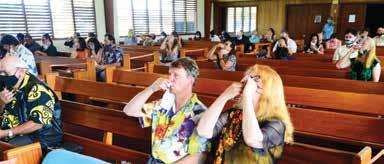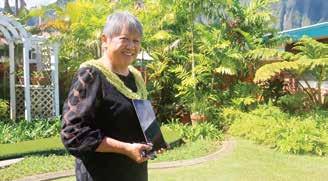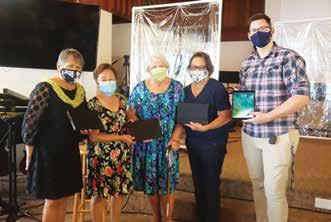
5 minute read
Hawaii Conference
Come to the Table:
Communion Service in a Pandemic
On October 10 and 17, two churches in Hawaii participated in something that many churches—for good reasons—have avoided: conducting communion service during the COVID-19 pandemic. With all of the public health limitations and precautions, it certainly makes a lot of sense to hold off on some elements of church life that are very involved, such as the ordinance of humility and the Lord’s Supper.
Yet, if communion service was accomplished, and safety protocols and precautions were honored in the process, a great opportunity to refresh weary souls by coming together in this special way would be a noteworthy footnote for a year full of virus-related cancellations, changes, and limitations.
Prayerfully, I decided to present the idea of attempting a pandemic-adjusted communion service to my churches in Hilo and Puna. I explained that we would have to follow safety guidelines and that this would call for some flexibility and changes to our traditional approaches for this service. I also emphasized that this would be a good way to rally our church family around what matters most: the sacrifice of Jesus Christ at the cross.
Both church boards warmly supported the idea, and after planning, praying, and rehearsing, we conducted our adjusted communion service. The serving parties and congregants wore masks. Instead of passing plates of wine and bread during the service, these items were pre-packaged in small sauce cups with lids and distributed in advance to our congregants. Physical distancing was maintained throughout the service, and congregants took the bread and wine when prompted in a selfserve style. One church opted to table the foot-washing service altogether, while the other church allowed persons who resided in the same household to do footwashing among themselves.
The highlight, however, was not the COVID-19 adjustments but rather the power that comes from the Holy Spirit when God’s people remember and receive anew the sacrifice of Jesus. “I am reminded of Matthew 5:16, which says, ‘Let your light so shine before men,’” said Fernando Martinez of the Hilo Church. “With communion, we were able to bring some normalcy to church. Starting with the sermon, we were reminded of the sacrifice that was made for us. The Spirit was moving in the congregation. As we entered into communion, I felt God’s presence there. As I looked around, I saw peace in everyone’s eyes. Having communion brought a sense of unity.”
For both the Hilo and the Puna churches, this was the only communion service held in the year, due to the pandemic. These two churches were willing to partner with God to accomplish something special, and maybe even rare, and they safely experienced communion service in these unconventional times.
Paul encourages us, “For whenever you eat this bread and drink this cup, you proclaim the Lord’s death until he comes” (1 Corinthians 11: 26, NIV). I believe God smiles whenever we proclaim the sacrifice of Jesus with gratitude and remembrance of His love in our hearts. ____________________ By Andre Weston
TOP: Hilo Head elder Fernando Martinez assists with communion cups. LEFT: Hilo church members take communion together.

Helping Our Kupuna Connect
When COVID -19 arrived, no one knew just how devastating it would be for our social interactions. The isolation from family and friends and the inability to gather socially has been hard on everyone, increasing feelings of loneliness and depression.
This is especially true for our elderly or kupuna, as they are called in Hawaii. For many of our kupuna, coming to the church building was the one time a week they could connect with others. The church gathering offered them the opportunity to see familiar faces and be part of a larger family. This was invaluable to their mental health and well-being; it was their connection to the outside world.
So, when churches were forced to go online, most of us adapted nicely, enjoying the chance to worship in our pj’s on our couches. However, many of our kupuna lack the technology or the know-how to navigate the social platforms many of us take for granted.
In the Kaneohe church, we noticed the lack of connection with many of our dear kupuna and sought to find a solution. Equipped with a generous technology grant from the president of the Hawaii conference, we were able to purchase several tablets and streaming devices for our kupuna to use to once again connect with their church families.
On October 3, a Sabbath afternoon, Josh Landenberger, Kaneohe technology ministries leader, led several of our kupuna in a training session on how
Elsie Frisbee shows off the tablet she used to conduct a muti-church Zoom week of prayer. A small group of kupuna gather to learn how to use technology to connect to ministry from Technologies Ministries leader Josh Landenberger.


to connect to our social media platforms using the tablets. Josh walked the excited and eager members through the process of how to connect to Bible studies on Zoom, how to watch livestreamed services, and even how to post thoughts and encouragement to others on Facebook.
“The reason we went with tablets is so that through preloaded Facebook, Zoom, YouTube, and the writings of Sister White, connection with their church ohana [family] would be a simple click away,” said Kaneohe Pastor Tim Nelson.
While there has been a learning curve, the kupuna have started to embrace the new technology. “It was the bane of my existence when I first tried to use it!” exclaimed Sue Costales. “However, getting to study with our ohana has been such a blessing.”
Several of the kupuna have not only embraced the tablets, they have started using them to reach out to other friends and family for Jesus. Recent tablet receiver Elsie Frisbee has already set up a week of prayer, a woman’s worship tea, and a worship talk with a mainland church—all using the new technology.
Kaneohe church is humbled yet excited to see how God is using this new ministry to connect its kupuna to each other and to the continuing mission of the church, in spite of COVID-19’s best efforts to separate us.










